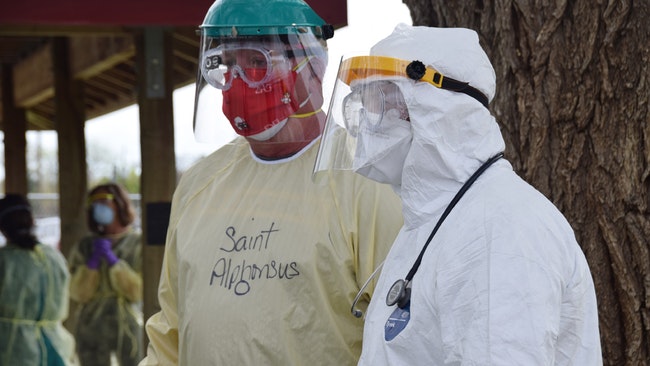
Health workers wait for cars to drive up at a testing site in Ontario on Wednesday, April 29. (The Enterprise/Yadira Lopez)
NOTE: This story has been updated with remarks from state Rep. Mark Owens.
ONTARIO – A “drastic increase” in COVID-19 infections in Malheur County means no return anytime soon to relaxed restrictions, the Malheur County Health Department has announced. The county had hoped to open restaurants and others businesses starting Friday, May 8.
The health agency on Saturday reported one new positive test for the respiratory disease. That made the fourth day in a row that new infections have been found – the longest streak for Malheur County since its first case on March 30.
The county has recorded 13 cases so far. Three have recovered and none have died, according to the health department.
“Malheur County Health Department officials are now anticipating a surge due to a drastic increase in cases in the last week,” the agency said in a Saturday statement.
The Malheur County Court last Wednesday approved a detailed plan for reopening the county. The plan, devised by health and emergency agencies, counted on a phased plan to keep control of the virus and start allowing modified operations of closed businesses such as restaurants and salons.
The county projected a starting date of May 8, but Gov. Kate Brown said on Friday that the earliest rural counties could begin phasing in eased restrictions would be May 15 if they meet certain conditions.
That now seems beyond Malheur County’s reach.
“Malheur County cannot safely reopen and lift the restrictions that have caused much sacrifice and hardship across our community with a significant increase in cases as we see now,” the health agency statement said.
State Rep. Mark Owens, R-Crane, said Sunday that he intends to press Brown to allow Malheur County to proceed with a revised opening plan. He said the governor is considering conditions that allow counties with fewer than five case to proceed.
He said the key should be not the number of cases but the ability of the local medical community to handle infections.
“If there are more than five cases and it that’s not overwhelming the medical community, we should be allowed to open,” Owens said.
He said Malheur County remains below another key measure – 5% positive rates from testing. He said as more testing is done, more positive results are going to occur.
“That’s something we’re going to have to live with,” Owens said.
The county health agency noted that testing for the respiratory disease has increased in the county, but the latest results don’t include data from 39 tests conducted on Wednesday, April 29, in a drive-through clinic in Ontario.
The agency said the increased testing should have resulted in a lower rate of people testing positive for the disease. That’s because the testing standards have been lowered, so it is not only the most obviously sick now getting tested.
Yet, the agency said, the rate of positive tests has been going up. Now, about 4% of those tested are determined to be infected. The rate had been hovering around 2.5% until Thursday, April 23, when it began climbing.
The increase in Malheur County cases is especially notable when compared to neighboring counties. Baker and Lake counties have yet to have any cases while Grant and Harney each have reported a single infected individual.
In Idaho, Payette County has reported 14 positive cases and one death.
Local officials and business leaders had been anticipating a relaxing of state restrictions across Malheur County to get the local economy moving again. The hospitality industry has been hit especially hard, with some restaurants closing and hotels reporting sparse occupancy.
The county agency again called on residents to help stop the virus from spreading by leaving home only for essential trips and observing social distancing standards, which includes staying six feet away from others while in public. There were reports that major retailers in Malheur County have been jammed with customers and that some workers weren’t wearing masks as advised by health officials.
“If people don’t simply take this seriously to reduce the likelihood that they could pass the virus without symptoms, we will be unable to open for a longer amount of time,” the agency said. “We can only flatten the curve of the upward trend in new cases by being more vigilant in prevention measures.”
The history of Malheur County cases:
March 30 – 1
April 2 – 1
April 10 – 1
April 11 – 1
April 15 – 1
April 23 – 1
April 26 – 1
April 29 – 1
April 30 – 2
May 1 – 2
May 2 – 1
Four weeks to reach 6 cases
One week to reach 7 new cases
NOTE: The Enterprise is providing free access to its content related to the coronavirus as a community service. Subscriptions at $5 a month help the Enterprise keep this up.




